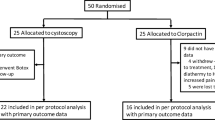Abstract
Introduction and hypothesis
Intravesical instillation of hyaluronic acid (HA) may restore the integrity of glycosaminoglycan layer in patients with painful bladder syndrome/interstitial cystitis (PBS/IC), and the benefit may be improved with addition of alkalinized lidocaine (AL).
Methods
48 women with severe PBS/IC who failed oral medications were enrolled and divided into one trial and two control groups. The trial group received intravesical 40 mg HA, 10 ml of 2 % lidocaine and 5 ml of 8.4 % sodium bicarbonate on a weekly basis for 8 weeks and then monthly for 4 months with a subsequent follow-up of 24 weeks, while the two control groups received 40 mg HA and mixture of 10 ml of 2 % lidocaine and 5 ml of 8.4%sodium bicarbonate respectively following the same procedure. Response to therapy was evaluated by Global Response Assessment, voids per day, Visual Analogue Scale for pain, frequency and urgency, O’leary-Sant Interstitial Cystitis Symptom Index and Problem Index, cystoscopy and bladder capacity.
Results
Overall 45 patients finished this study protocol. The HA + AL group and the AL group showed significant improvement at week 2 (P < 0.01), while the HA group began to show effect at week 4 (P < 0.01). There was no improvement in the AL group at week 24 and these patients quitted the study without follow up. Contrarily, the HA + AL and HA group kept on improving till the end of the study without significant difference between the two groups.
Conclusions
Intravesical instillation of HA and AL may provide both immediate and sustained relief of symptoms in severe PBS/IC in this preliminary study.

Similar content being viewed by others
References
Hanno P, Lin A, Nordling J et al (2010) Bladder pain syndrome committee of the international consultation on incontinence. Neurourol Urodyn 29(1):191–198
Wein AJ, Hanno PM (2002) Targets for therapy of the painful bladder. Urology 59:68–73
Grover S, Srivastava A, Lee R, Tewari AK, Te AE (2011) Role of inflammation in bladder function and interstitial cystitis. Ther Adv Urol 3(1):19–33
Parsons CL (2007) The role of the urinary epithelium in the pathogenesis of interstitial cystitis/prostatitis/urethritis. Urology 69:9–16
Teichman JM, Moldwin R (2007) The role of the bladder surface in interstitial cystitis/painful bladder syndrome. Can J Urol 14(4):3599–3607
Morales A, Emerson L, Nickel JC (1996) Intravesical hyaluronic acid in the treatment of refractory interstitial cystitis. J Urol 156:45–48
Riedl CR, Engelhardt PF, Daha KL, Morakis N, Pflüger H (2008) Hyaluronan treatment of interstitial cystitis/painful bladder syndrome. Int Urogynecol J Pelvic Floor Dysfunct 19(5):717–721
Engelhardt PF, Morakis N, Daha LK, Esterbauer B, Riedl CR (2011) Long-term results of intravesical hyaluronan therapy in bladder pain syndrome/interstitial cystitis. Int Urogynecol J Pelvic Floor Dysfunct 22(4):401–405
Nickel JC, Moldwin R, Lee S, Davis EL, Henry RA, Wyllie MG (2009) Intravesical alkalinized lidocaine (PSD597) offers sustained relief from symptoms of interstitial cystitis and painful bladder syndrome. BJU Int 103(7):910–918
Wein AJ, Hanno PM, Gillenwater JY (1990) Interstitial cystitis: an introduction to the problem. Interstitial cystitis. London, Springer-Verlag, pp 3–15
Dasgupta J, Tincello DG (2009) Interstitial cystitis/bladder pain syndrome: an update. Maturitas 64(4):212–217
Hanno PM, Burks DA, Clemens JQ et al (2011) AUA guideline for the diagnosis and treatment of interstitial cystitis/bladder pain syndrome. J Urol 185(6):2162–2170
Payne CK, Mosbaugh PG, Forrest JB et al (2005) Intravesical resiniferatoxin for the treatment of interstitial cystitis: a randomized, double-blind, placebo controlled trial. J Urol 173(5):1590–1594
Propert KJ, Mayer R, Nickel JC et al (2008) Followup of patients with interstitial cystitis responsive to treatment with intravesical bacillus Calmette-Guerin or placebo. J Urol 179(2):552–555
Leppilahti M, Hellstrom P, Tammela TL (2002) Effect of diagnostic hydrodistension and four intravesical hyaluronic acid instillations on bladder ICAM-1 intensity and association of ICAM-1 intensity with clinical response in patients with interstitial cystitis. Urology 60(1):46–51
Shao Y, Shen ZJ, Rui WB, Zhou WL (2010) Intravesical instillation of hyaluronic acid prolonged the effect of bladder hydrodistention in patients with severe interstitial cystitis. Urology 75(3):547–550
Cervigni M, Natale F, Nasta L, Padoa A, Voi RL, Porru D (2008) A combined intravesical therapy with hyaluronic acid and chondroitin for refractory painful bladder syndrome/interstitial cystitis. Int Urogynecol J Pelvic Floor Dysfunct 19(7):943–947
Parsons CL (2005) Successful downregulation of bladder sensory nerves with combination of heparin and alkalinized lidocaine in patients with interstitial cystitis. Urology 65(1):45–48
Welk BK, Teichman JM (2008) Dyspareunia response in patients with interstitial cystitis treated with intravesical lidocaine, bicarbonate, and heparin. Urology 71(1):67–70
Conflicts of interest
None.
Author information
Authors and Affiliations
Corresponding author
Additional information
Each authors’ contribution to the Manuscript:
Yi-Song Lv: Project development, Data collection, Manuscript writing
Hui-Liang Zhou: Project development, Data collection
Hou-Ping Mao: Data collection
Rui Gao: Data collection, Data analysis
Yan-Dong Wang: Manuscript writing and editing
Xue-Yi Xue: Data collection
Rights and permissions
About this article
Cite this article
Lv, YS., Zhou, HL., Mao, HP. et al. Intravesical hyaluronic acid and alkalinized lidocaine for the treatment of severe painful bladder syndrome/interstitial cystitis. Int Urogynecol J 23, 1715–1720 (2012). https://doi.org/10.1007/s00192-012-1802-3
Received:
Accepted:
Published:
Issue Date:
DOI: https://doi.org/10.1007/s00192-012-1802-3




